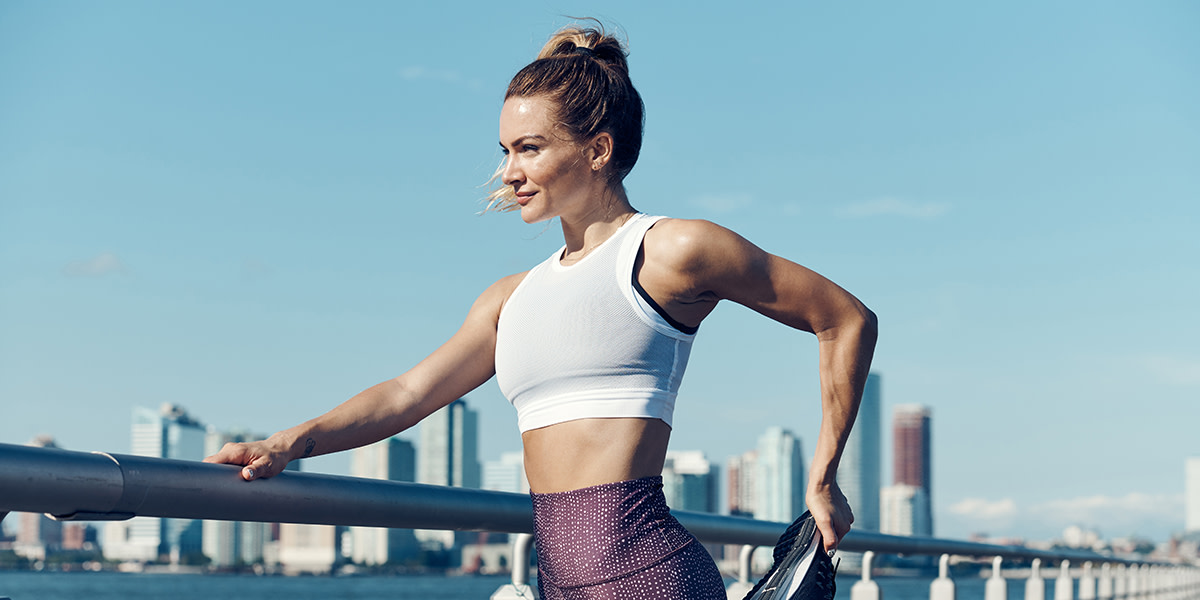If you’re working out, you need to be stretching, but knowing the right types and length of stretches to do can require a little more knowledge. Caring for your body before and after a workout is crucial to hitting your next milestone, so to learn more we’ve recruited Peloton instructors Jess Sims and Leanne Hainsby to share the types of stretches to use before and after a workout and how they can keep you safe and strong for your next one.
The Benefits of Regular Stretching
Incorporating a regular stretching routine before and after your workout not only allows you to stay safe but sets yourself up for future fitness success. “A consistent stretching routine will enable you to have a more effective and improved workout because you will slowly but surely be increasing your flexibility and range of motion,” says Peloton Bike instructor Leanne Hainsby. “For example, on the bike you will start to understand and naturally elongate your spine to sit tall and proud on your saddle and create space between your hips and your ribcage for your legs to move freely and smoothly,” she explains. “A body that is being consistently stretched will have more energy, and we all want to find ways to keep our energy up!” This means the same when it comes to increased flexibility and mobility during your Tread workouts notes Peloton Tread instructor Jess Sims. “This means that you’ll be able to get deeper into that push up or squat, handle heavier loads and reduce your chance of injury!”
Dynamic vs. Static Stretching
Leading up to each workout, Jess suggests engaging in a more dynamic stretching routine to prepare your body for the different types of movements ahead. “This type of warmup will mimic movements you might encounter during your workout to prepare your muscles for a particular workout” says Jess. Prior to your next workout, incorporate more dynamic ways to warm up with stretches that Jess suggests below:
Hamstrings: Try inchworm walk-outs--slowly walking your hands out into a high plank position and then walking them back toward your feet.
Hip Opener: Hold a high plank and bring the right foot outside the right hand and repeat on the other side. Standing “knee hugs” or a slow high knees movement can also be used to open the hip area.
T-Spine Stretch: Stay in the hip opener position explained above, keep your right foot outside your right hand and reach the right hand up toward the ceiling with your left hand flat on the floor. Repeat on the other side. For an added hamstring stretch, from this position, lower your left knee and push your butt back toward your right heel and repeat on the other side.
Upper Back, Shoulders and Calves: Hold a plank and push back to downward dog.
Quads: Perform “standing grabs” by grabbing your foot behind you for a quick quad stretch, making sure to alternate on either side.
Jess also suggests saving your static stretching for when your body has been warmed up from your workout. “You don’t want to do static stretching when you’re cold because you’re pulling on muscles that are currently stiff,” she says. “It’s perfect for after a workout so that you can elongate the muscles and increase blood circulation.” Leanne encourages you to try to take 5 to 10 minutes after your workout to fit in that static stretch session. “Give yourself time to cool down and open your muscles,” says Leanne. “Remember not to bounce in your stretches though--this may tear your muscles which can lead to scar tissue, tight muscles, decreased flexibility and increased soreness.” Fitting in your stretching session right after your workout is also an effective way to remember to actually do it and free up time for other things in your agenda. “Stretching is such a perfect way to wrap up a workout and can have a positive impact on the rest of your day,” says Leanne. “Also, by doing it within the time you’ve dedicated to working out, it means you’re not having to find the time elsewhere in your day!”
Sneak In A Stretch
If you don’t have ample time after a workout to fit in a full stretching routine, that doesn’t mean you should forget about it for the day. There are several creative ways to fit stretching into your daily movements to keep your body safe and healthy as you go about your life, both to compensate for a shorter stretching routine and to counteract daily stress. Jess suggests these three simple stretches you can do anytime, anywhere:
Upper Back: Place your hands on a desk or table and with a soft bend in the knees, push your hips back and press your palms into the surface to feel an upper back stretch.
Chest Opener: Sitting on the floor, put your hands flat on the ground behind you and squeeze your shoulder blades together to open up your chest.
Neck Stretch: Take your right hand and put in on top of the left side of the top of your head. Gently guide your head to the right to feel a nice stretch on the left side of the neck. Repeat on the other side.
